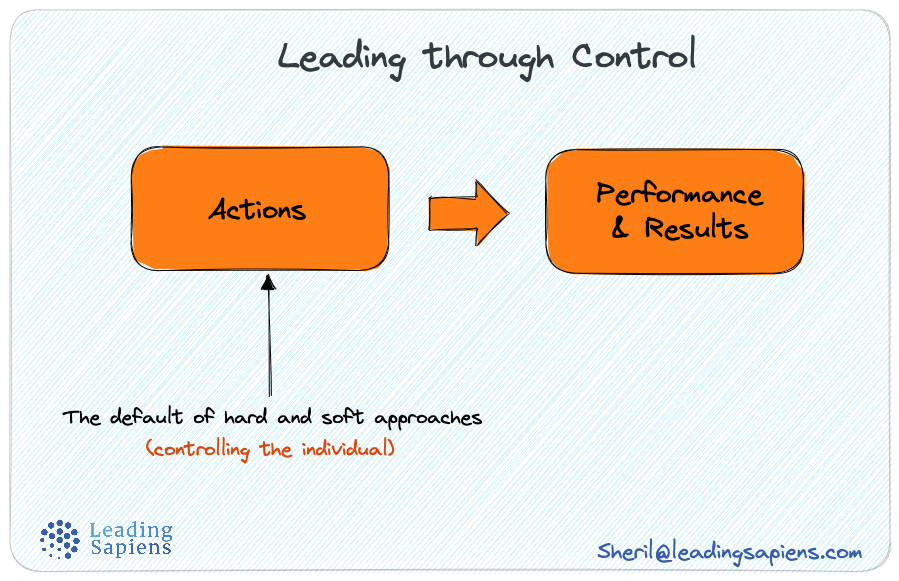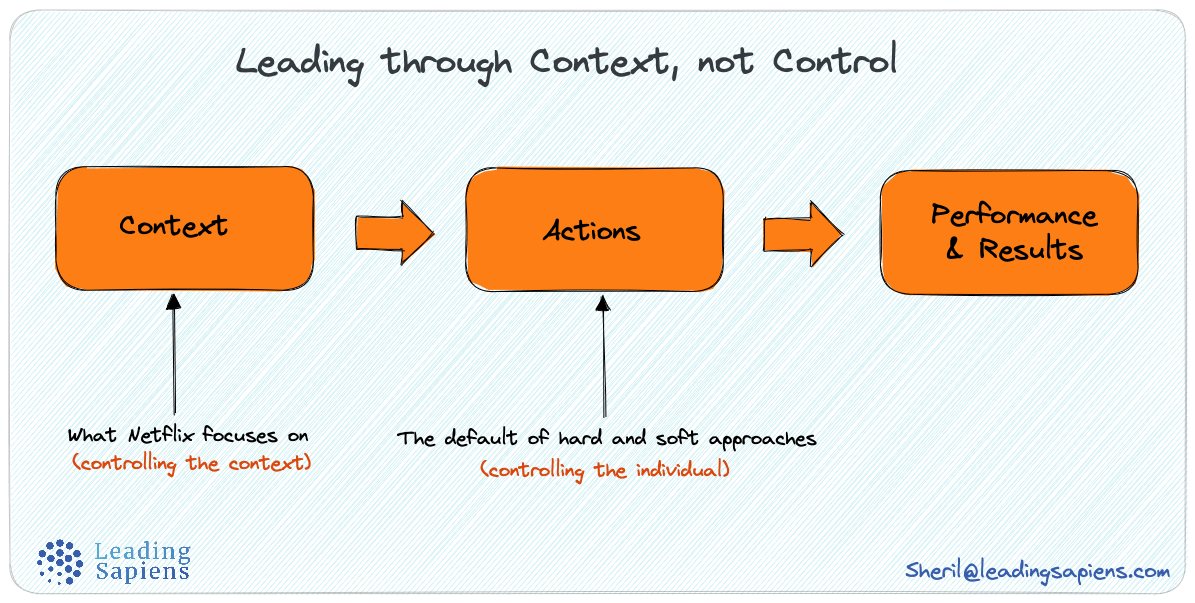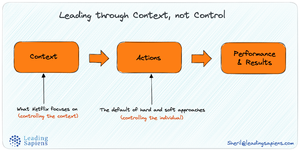Control was the dominant management paradigm in early twentieth century industrial factories. A century later, in many modern workplaces it continues to be dominant and mostly goes unquestioned. Often we don’t even realize that this is the case.
But in knowledge work, context is a far more effective and sustainable approach to performance, than control. What is leading by context and how is it different from leading by control? Unfortunately, most managers are unaware of this subtle but fundamental difference in approach to people and organizations.
The anomaly that is Netflix
Consider the following list of policies that are considered “standard” in most organizations:
Vacation Policies, Expense Policies, Decision-Making Approvals, Decision Making by Committee, Performance Improvement Plans, Key Performance Indicators, Management by Objectives, Travel Policies, Approval Processes, Contract Sign-Offs, Salary Bands, Pay Grades, Pay-Per-Performance Bonuses, Raise Pools
— from No Rules Rules by Reed Hastings, Erin Meyer
These are pervasive to the point where we take them for granted and don’t question their existence. The ones listed are pretty standard ones but it doesn’t stop there. Based on the organization and type of work, there’s a million different variations and additional types of controls that management imposes to increase “compliance”.
Netflix is a 100 billion+ dollar company and operates without any of the above policies. How do they pull it off? The clue is in one of their leadership mantras: “Lead with context, not control”.
As a society, we’ve had hundreds of years to work on managing industrial firms, so a lot of accepted HR practices are centered in that experience. We’re just beginning to learn how to run creative firms, which is quite different. Industrial firms thrive on reducing variation (manufacturing errors); creative firms thrive on increasing variation (innovation).
— Reed Hastings quoted in How Netflix Reinvented HR by Patty McCord in Harvard Business Review
Leading through control
What drives performance and results? Thousands of books, and even more thousands of research papers have been written about performance and how to improve it. But at it’s very basic, the simplest model is that actions and behavior drive performance. Thus changing actions changes the ensuing performance and results.
All typical managerial actions are designed to directly influence actions and behavior and generally fall into two buckets: hard and soft. [2,3]

Hard approaches are based on data, structures, and financial stimuli — think KPIs, OKRs, org charts, processes, functions, reorgs, quality metrics, training, and policies amongst others.
Soft approaches are based on psychological stimuli — think incentives (cash and non-cash) , disincentives, punitive measures, “morale boosting” activities like team building, recognitions, off sites, office socials, holiday parties and so on.
Both approaches, are supposed to drive the “right” kinds of behavior and thus performance. When performance falters, management goes right back to modifying these levers.
The fundamental problem is that this tries to cure the symptoms rather than the cause thus creating a never ending vicious loop. The mistake is in trying to intervene in the action itself.
Leading through context
In both hard and soft approaches that epitomize control, the underlying ethos is of controlling the individual and one main assumption — that people cannot be trusted to do the right thing or take the best decision, and that they won’t do it without external oversight or the right incentives.
Bear in mind, we are talking about systems and assumptions that have been in place for over two centuries dating back to the industrial revolution. So even employees have been programmed to think that way.
Context on the other hand, assumes that people will make the right decisions and take the right action, given the right input. The leader and manager’s role is not necessarily to dictate and direct the action but rather on creating an environment that enables the right behavior.

Every decision and the actions that follow have an overarching context in which they are undertaken. Managers should be focused on influencing this context.
📚 HBR 100 Best Reads: You also get a curated spreadsheet of the best articles Harvard Business Review has ever published. Spans 70 years, comes complete with categories and short summaries.
In their book No Rules Rules, Reed Hastings and Erin Meyer highlight why Netflix emphasizes context over control, and how they go about it.
If you’ve got high-performing employees, leading with context is best. To encourage original thinking, don’t tell your employees what to do and make them check boxes. Give them the context to dream big, the inspiration to think differently, and the space to make mistakes along the way.
...
The best managers figure out how to get great outcomes by setting the appropriate context, rather than by trying to control their people.
Leadership with control is familiar to most. The boss approves and directs the initiatives, actions, and decisions of the team. Sometimes she may control employees’ decisions through direct oversight—telling them what to do, checking in frequently, and correcting any work that isn’t done as she desires. Other times she may seek to empower her employees more, avoiding direct oversight but putting control processes in place instead.
Leading with context, on the other hand, is more difficult, but gives considerably more freedom to employees. You provide all of the information you can so that your team members make great decisions and accomplish their work without oversight or process controlling their actions. The benefit is that the person builds the decision-making muscle to make better independent decisions in the future.
The biggest difference between the context and control approaches is autonomy and leeway to make both small and large decisions, ability to use creativity and ingenuity, and using real time responsiveness to complexity rather than behaviors based on rules dictated from above.
But for context to work, there are underlying conditions to make sure that it in fact works. Some industries, like nuclear for example, are probably not as well suited for context to work at an organizational level. In contrast, more creative fields have a natural advantage.
Even then, at the managerial and individual levels context is still a lot more effective approach over control. In the day to day decision making of individual contributors, setting context gives more autonomy and creates more engagement compared to controlling every step of the process.
Three requirements for context to work
Hastings and Meyer highlight three preconditions that have to be in place for context to work across entire organizations:
- High talent density.
- Goal as innovation rather than error prevention.
- Balance of alignment and loose coupling.
1. High talent density
The first question you need to answer when choosing whether to lead with context or control is, “What is the level of talent density of my staff?”
If your employees are struggling, you’ll need to monitor and check their work to ensure they are making the right decisions. If you’ve got a group of high performers, they’ll most likely crave freedom and thrive if you lead with context.
2. Innovation vs safety (eg. Target vs Exxon)
You also have to consider your industry, and what you are trying to achieve. …The second key question to ask is whether your goal is error prevention or innovation.
If your focus is on eliminating mistakes, then control is best. ExxonMobil is in a safety-critical market. Its sites need hundreds of safety procedures to minimize the risk of people getting hurt. Control mechanisms are a necessity when you’re trying to run a dangerous operation profitably with as few accidents as possible.
3. Balancing high alignment and loose coupling
Tightly vs loosely coupled companies
A tightly coupled system is one in which the various components are intricately intertwined. If you want to make a change to one area of the system, you have to go back and rework the foundation, which impacts not just the section you need to change, but the entire system.
By contrast, a loosely coupled design system has few interdependencies between the component parts. They are designed so that each can be adapted without going back and changing the foundation.
When a company is tightly coupled, big decisions get made by the big boss and pushed down to the departments, often creating interdependencies between the various areas of the business. If a problem occurs at the departmental level, it has to go back to the boss who oversees all of the departments.
Meanwhile, in a loosely coupled company, an individual manager or employee is free to make decisions or solve problems, safe in the knowledge that the consequences will not ricochet through other departments.
Highly Aligned
If loose coupling is to work effectively, with big decisions made at the individual level, then the boss and the employees must be in lockstep agreement on their destination. Loose coupling works only if there is a clear, shared context between the boss and the team. That alignment of context drives employees to make decisions that support the mission and strategy of the overall organization. This is why the mantra at Netflix is HIGHLY ALIGNED, LOOSELY COUPLED
Creating context takes more skill and work
So why don’t managers focus on context? For one, it’s not easy and goes against the grain of default behavior.
Secondly, it takes a lot more work and persistence to ensure context, as opposed to the easy way of putting controls in place and expecting them to do the magic, or simply throwing more resources and processes at recurring problems.
Hastings outlines how he goes about setting context from a CEO’s perspective. It’s obvious that context clearly takes a lot more work compared to just barking orders and expecting everyone to follow directives from up above.
I use a handful of methods for setting context across the company, but my primary platforms are our Executive Staff and our Quarterly Business Review (QBR) meetings. A few times a year we bring together all the leaders (top 10 to 15 percent of people) of the company from around the world.
...
The number one goal for these meetings is to make sure that all leaders across the company are highly aligned on what I call our North Star: the general direction we are running in. We don’t need to be aligned on how each department is going to get where they are going—that we leave to the individual areas—but we do need to make sure we are all moving in the same direction.
...
Between QBRs, I hold ongoing one-on-one meetings to get a feel for how aligned we actually are and where context is lacking. I have one thirty-minute meeting with each director once a year. That makes about 250 hours of meetings with people who are three to five levels below me in the org chart. In addition, I meet with each vice president (two to three levels below me) for one hour every quarter. This results in another 500 hours of meetings annually.
...
These one-on-one meetings help me to better understand the context in which our employees are working, and alert me to areas where our leadership is not aligned so that I can revisit key points at the next round of QBR meetings.
Creating the context to enable better decisions further downstream not only takes more skill but also more investment of time upfront.
What it looks like
If you are leading through context what does it look like in practice? Hastings and Meyer give some examples.
An alternative to expense policies
During the ten years that David Wells was CFO he set the first round of context for incoming recruits at our “New Employee College.” He explained it like this:
Before you spend any money imagine that you will be asked to stand up in front of me and your own boss and explain why you chose to purchase that specific flight, hotel, or telephone. If you can explain comfortably why that purchase is in the company’s best interest, then no need to ask, go ahead and buy it. But if you’d feel a little uncomfortable explaining your choice, skip the purchase, check in with your boss, or buy something cheaper.
This is what I mean by “context at the front end.” David’s instruction to imagine explaining your purchases to your bosses is not a simple exercise in make-believe. If you aren’t careful with your spending, you likely WILL have to explain your purchases.
The decision making pyramid vs tree
The pyramid decision-making structure … is easily recognizable in the majority of organizations, regardless of industry or location. Either the boss makes the decision and pushes it down the pyramid for implementation, or those at lower levels make the smaller decisions but refer the bigger issues to the higher-ups.
But at Netflix…the informed captain is the decision maker, not the boss. The boss’s job is to set the context that leads the team to make the best decisions for the organization. If we follow this leadership system from the CEO all the way to the informed captain, we see that it works not so much like a pyramid but more like a tree, with the CEO sitting all the way down at the roots and the informed captain up at the top branches making decisions.
Is it their mistake or did you fail to set context?
When one of your people does something dumb, don’t blame that person. Instead, ask yourself what context you failed to set. Are you articulate and inspiring enough in expressing your goals and strategy? Have you clearly explained all the assumptions and risks that will help your team to make good decisions? Are you and your employees highly aligned on vision and objectives?
Are you still making all the decisions?
You know you’re successfully leading with context when your people are moving the team in the desired direction by using the information they’ve received from you and those around you to make great decisions themselves.
Video: Reed Hastings explaining leading with context not control
HBR 100 Best Reads: You also get a curated spreadsheet of the best articles Harvard Business Review has ever published. Spans 70 years, comes complete with categories and short summaries.
Related reading
Context continues to be an under leveraged aspect of leadership. When in doubt, consider the poem below from Antoine de Saint-Exupery that perfectly captures the essence and dynamic of context vs control:
If you want to build a ship,
don’t drum up the people
to gather wood, divide the
work, and give orders.
Instead, teach them to yearn
for the vast and endless sea.
— Antoine de Saint-Exupery
- In Importance of Mastering Context in Leadership I take a deeper, higher level look at what makes context so effective in leadership.
- Unfortunately, leaders continue to delve in the paradigm of control. In Tyranny of Content and Control I look into why leaders keep focusing on control and content.
- The Netflix culture deck that went viral in 2009 is still a valuable read for unconventional but common sense approaches to building teams and organizations.
- No Rules Rules is an excellent read, if not for anything but to challenge what's often taken for granted about performance and organizations.
Sources and references
- No Rules Rules: Netflix and the Culture of Reinvention by Reed Hastings and Erin Meyer.
- Strategic Workforce Engagement by Yves Morieux and Robert Howard, Boston Consulting Group.
- Six Simple Rules: How to Manage Complexity without Getting Complicated by Yves Morieux and Peter Tollman.
- Latest Netflix culture page with some more good examples: https://jobs.netflix.com/culture
- How Netflix Reinvented HR by Patty McCord in Harvard Business Review.


